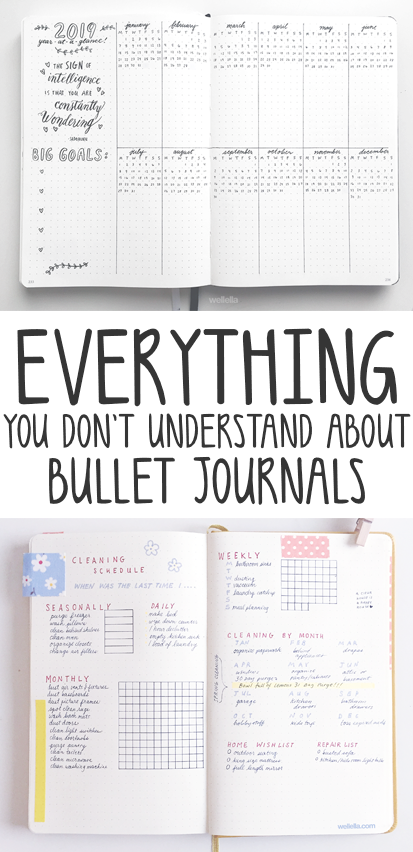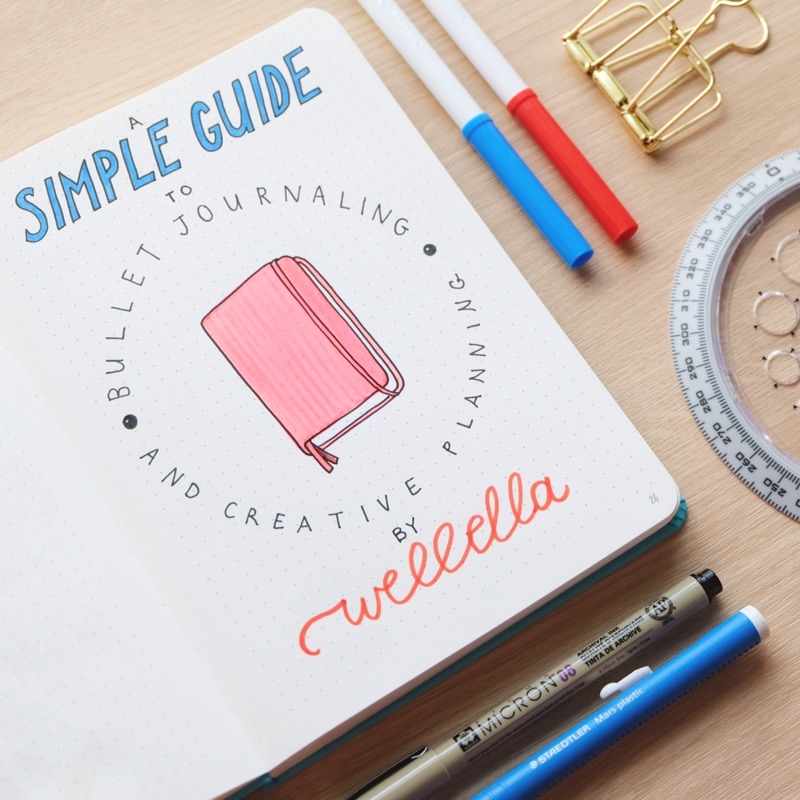So, you wanna know what’s a bullet journal, do you? Maybe you’ve already seen lots of cool bullet journal ideas on Pinterest, or even checked out some YouTube videos, but you’re still not quite sure how to bullet journal.
This nifty and thorough bullet journal guide explains how it all works.
What is a bullet journal?
In the words of bullet journal creator Ryder Carroll, the bullet journal is a “mindfulness practice disguised as a productivity system.”
My simpler bullet journal definition is this: it’s a notebook that keeps you organized using a special system.
The notebook part is simple (use whatever you want), but the system part is what throws people off.
I, like many others before me, found jargon such as Future Log, Signifiers, and Migration to be utterly perplexing. After much reading, I realized that the system is actually simple, practical, and yes – it works.
If you like writing with pen and paper, like making to-do lists, want to improve your habits, or want to get better at not wasting time, a bullet journal will be worth it for you!
If you’re confused about all the funny words bujo-ers use (like bujo), check out my bullet journal glossary post. It’s an explainer that should help you understand the terms and abbreviations commonly used in the planner community.
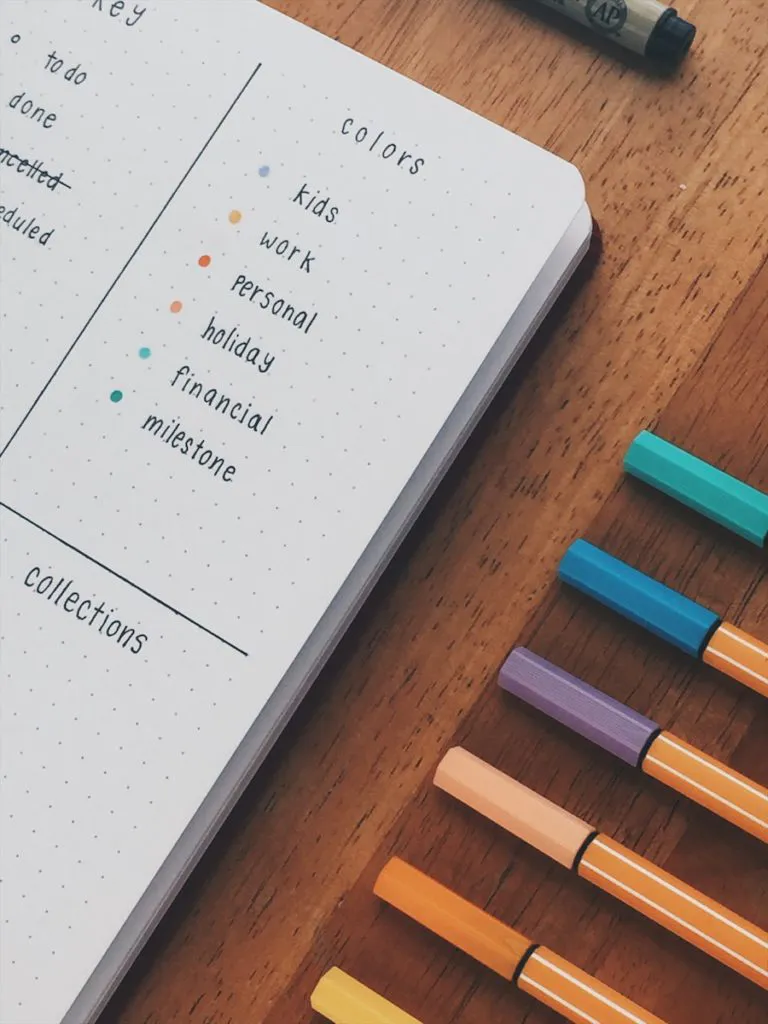
How To Bullet Journal In 5 Easy Steps
Before you start a bullet journal, you’re gonna need to create a kind of framework. This framework is what makes the bullet journal method work.
The bullet journal method is made up of several different modules:
– a table of contents (the Index Page)
– a yearly overview (the Future Log)
– monthly overview pages (Monthly Logs)
and
– weekly or daily overview pages (Weekly and Daily Logs)
Without this framework, all you’ve got is a notebook with notes, amirite? So here are the basic bullet journal steps to get you started:
Step One – Index Page
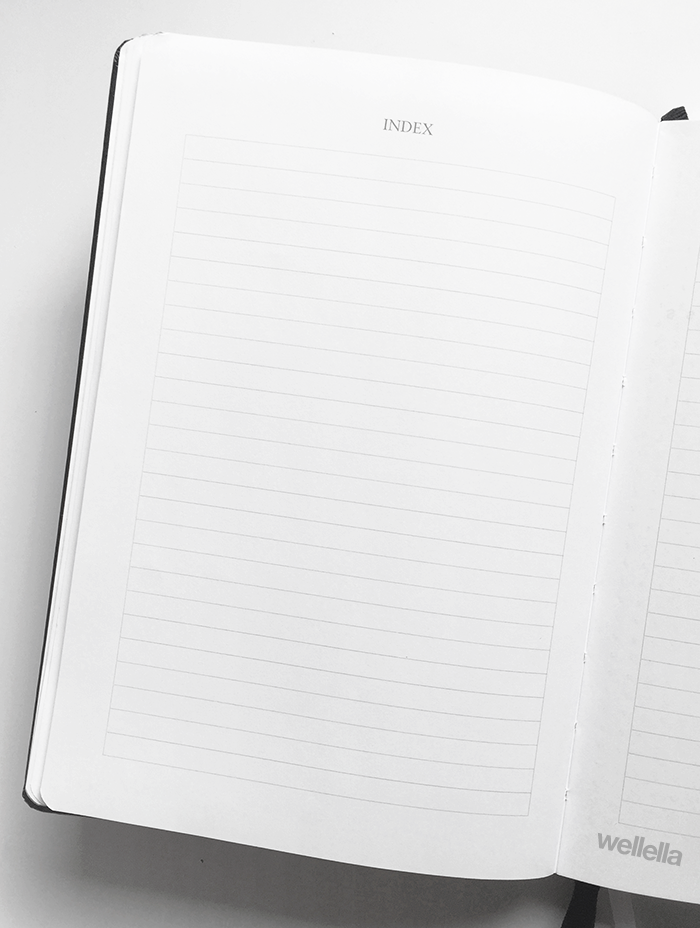
As mentioned above, the bullet journal index page is like a table of contents, helping you keep track of where things are located in your notebook. In order do to this, you’ll first need to number the pages in your journal.
Once you’ve got numbered pages, you can designate a page or two to use as your index. In the same way that books usually put the table of contents right at the front, most bullet journalers put their index on the first page or two of their journal.
You don’t need to do anything too fancy here for now, just maybe write the word “Index” as a header. Later, you’ll fill in this area with the important topics in your journal and what page to find them on.
Pretty spiffy, eh?
Step Two – Future Log

The Future Log gives you an overview of the year ahead. Like a calendar.
So in your Future Log you’ll write down all the birthdays, events, appointments, and other important dates coming in the months ahead.
Here’s another future log example:
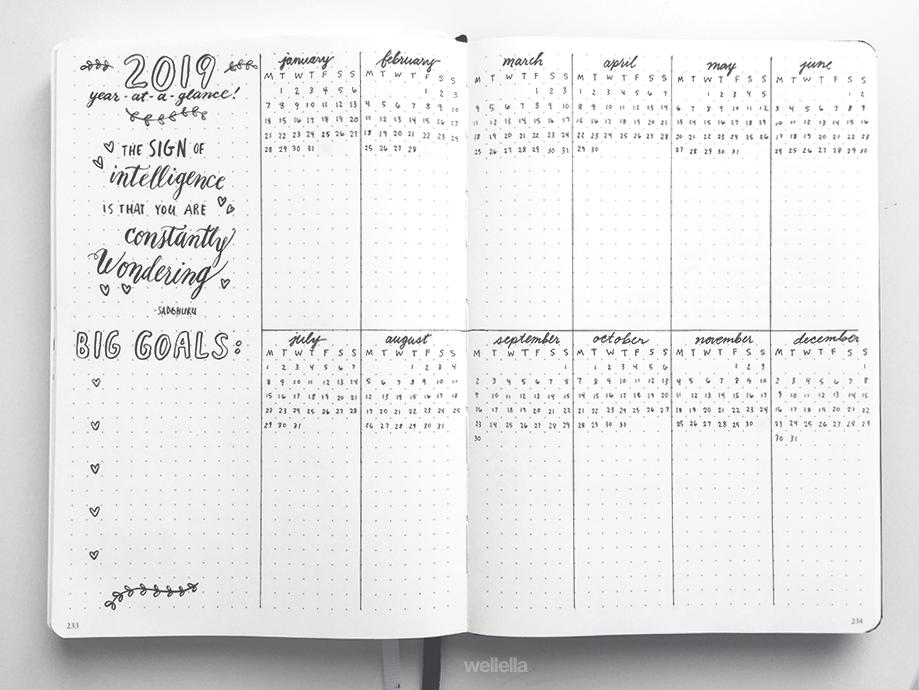
Now, you must be wondering, what comes after the future log? I’ll tell you.
It’s your first monthly log. Yay!
(See more future log layout ideas)
Step Three – Monthly Log
The Monthly Log gives you a big-picture view of the month ahead.
A monthly calendar spread is where you can write down all the happenings, events, birthdays, goals, monthly tasks, etc.
You’ll create a new monthly log at the start of each month. If you’re setting up your bullet journal for the first time, during the middle of the month, just make a monthly log for the current month.
The basic set up for the monthly log is to use two facing pages.
On one side, you can put a calendar page. Some people put a list of all the days of the month, some prefer to make a calendar grid. You do you.
Once you’ve created the calendar, just log your upcoming events. You can also add them in as they occur later.
On the facing page, list your goals, objectives, monthly tasks. I like to write down any holidays and special awareness themes for the month here as well.
As you can see if you’ve been following along with these steps, making a bullet journal is not that hard. There’s one more special page to set up.
Step Four – Weekly Log
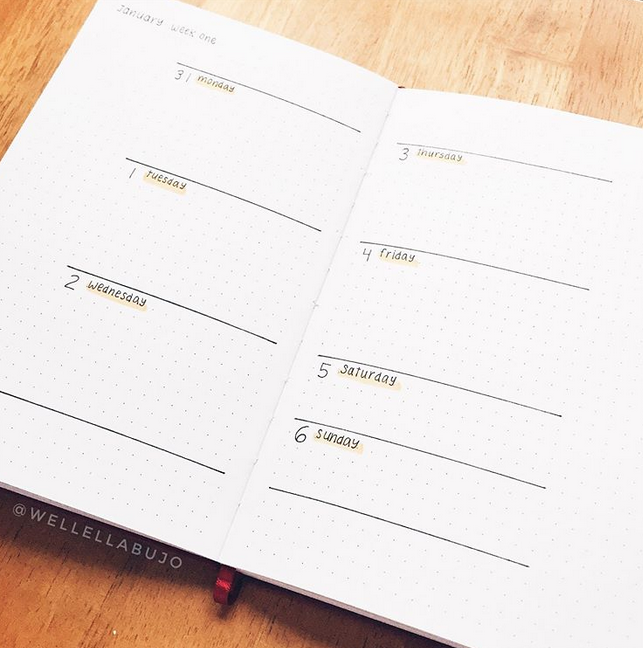
Okay, so weekly logs were not originally included in the official bullet journal set up.
BUT from what I see, most bullet journalers make them.
It’s useful to see what you’ve got going on for the rest of the week, and to see how far away you are from the weekend, is it not?
To make a weekly log, you can either use a single page, or two facing pages. I recommend starting out with two facing pages. If you find that you still have plenty of blank space after a week, you can cut back to using only one page for the next week.
All you need to do here is write out the days of the week, equally spaced. The typical weekly spread layout is some kind of grid. In the above example I wanted to keep it simple-looking by using only horizontal lines.
(Check out more bullet journal weekly spreads here!)
Step Five – Daily Log
Daily logs are the bread and butter of bullet journaling. This is where you’ll keep a running list of tasks, events, and notes for the day. It’s kind of like a daily to-do list, but where you also log things you want to remember.
For example, if you have any appointments, meetings, classes, or things you need to get done for the day, write them in your daily log.
The daily log is also a good place to keep track of what happened during the day. If you want to track your water intake, you can write down how many glasses of water you drank. You can log your exercise, reading, what you ate, or any other things you did.
If you’re using a weekly log, you can just do your daily logging in the areas you already wrote out for each day.
Now that your bullet journal is all set up, let’s look at how to actually use it.
Remember that special system I mentioned at the beginning of this post? Well, when you write down bits of information in your bullet journal, you’ll use something called Rapid Logging. {OMG more jargon…?!?!}
Rapid Logging
Rapid Logging is merely a fancy word that means “notetaking using different-looking bullet points.”
The reason for using specific bullet points is actually to make it quick and easy to jot down important stuff.
Instead of using different colors or highlighters to emphasize an event or priority, if you use different bullet points for these things, you can keep on using the same writing utensil. So, Rapid Logging is a time-saver.
Here are some typical bullet symbols and what they indicate:
• is for tasks
× is for completed tasks
O is for events
— is for notes
If you didn’t complete a task, but move it to the next day, week, or month, or schedule it for a specific date, you can change the bullet dot (to show that it has been accounted for) like this:
> is for migrated tasks
> is for scheduled tasks
You can add extra indicators to your bullets using more specific symbols, which are called signifiers.
Here are some signifiers you can use:
⁕ is for priorities
eye is for explore (something you want to look into more later)
! is for inspiration
$ is for something you want to buy
Of course, you can change up the symbols or create your own set. I recommend trying out the original system as it’s explained and then alter it to suit your needs.
Whatever symbols you decide to use, you can create a small reference for them in your journal so you don’t forget what they mean. This is called your key.
Another cool way you can do your key is to create a little flip-out paper, so you can see it easily no matter what page you’re writing in.
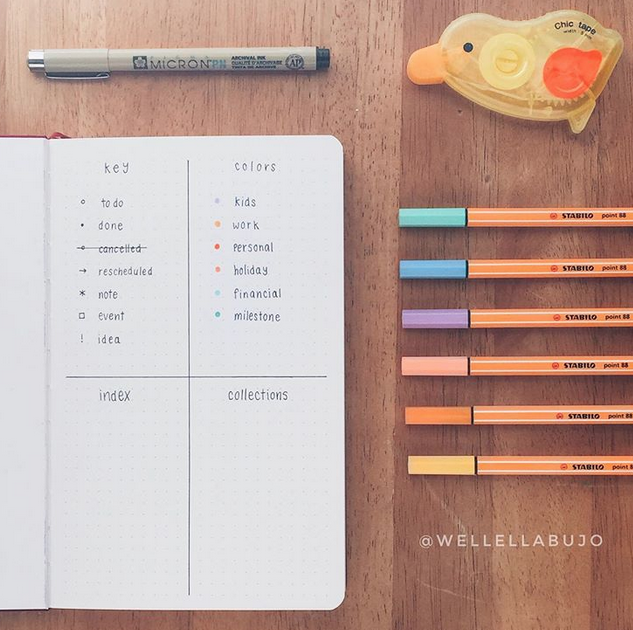
Check out my post { Bullet Journal Key Examples } for LOTS of really cool, cute, and handy examples of different bujo keys.
Now that we’ve covered all the basics of how to set up a bullet journal, let’s look at some more fun ideas for things you can put in your bullet journal.
Bullet Journal Trackers
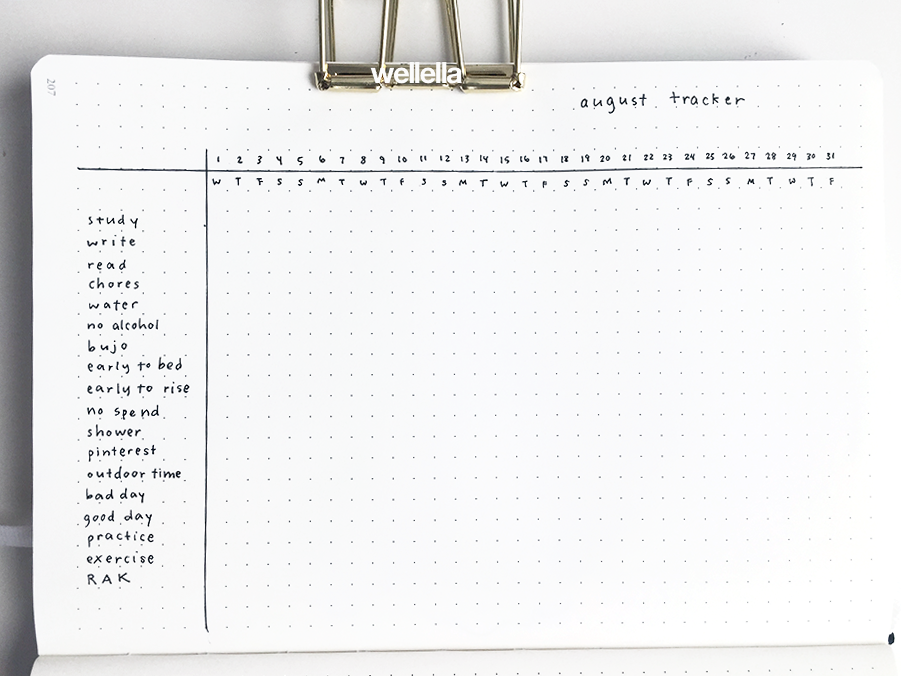
Trackers help you stay on top of your goals and keep track of anything from money saved to pounds lost.More Bullet Journal Fonts
The sky is the limit when it comes to creating whatever trackers you want, but here are some of the most common:
- Weight loss
- Steps taken per day
- Alcohol consumption
- Menstrual cycle
- Money saved
- Is there something you’d like to save up for? A vacation, a house, a car… perhaps a new computer? Or perhaps you’d just like to build your savings up to create a safety net? You can use your bullet journal to create a money tracker to remind yourself of your savings goals, and keep track of them. Check out some bujo money tracker ideas.
- Money spent
- Tracking money spent is also quick and easy to do in your bullet journal. I myself track all the money I spend on my blog/business in my bullet journal, which helps me enter that information into my accounting software (which I hate opening up because it’s boring) at a later time. Tracking your spending is a great idea for students and anyone who’ wants to live on a budget.
- Student loan/Debt payments
- Having debt is no fun, but many finance experts say that making a visual tracker can help you feel motivated to pay it off more quickly. Seeing the progress made as you continue to pay off a debt will inspire you to keep going. You can create a special debt payoff tracker in your bullet journal to do just that.
- Social media followers or posts
- A social media tracker is where you can track your follower growth on all the social media platforms you participate in. It’s great for anyone (like myself) who is working on long-term blogging or business goals where social media growth is beneficial.
- Cleaning
- So, most people don’t like cleaning that much. We mostly do it when we notice we have to, or when we have guests coming over, ya? A bullet journal cleaning schedule can help you keep your home in better shape by reminding you of when you last cleaned something. It’s a daily, weekly, or monthly plan you can refer back to to stay on track with whatever you feel is a manageable cleaning routine for your home.
- Sleep
- Another thing many people wish to improve in their lives is the amount of sleep they get. I know I am! A bullet journal sleep tracker will help you learn about your sleep patterns and encourage you to make adjustments. Once you start tracking your sleep, you may realize that you’re getting much less sleep than what you thought. Reviewing the tracker should make it easier to see where you can try to make improvements.
- Other habit tracker ideas to try:
- There are a million and one things you could potentially track in your bullet journal. Some ideas are:
- How much water you drank
- If you exercised, for how long/what type/what you focused on, etc.
- What foods you ate, whether you met your daily caloric or macro targets
- Whether you abstained from drinking alcohol, coffee, smoking, or anything else you’re trying to give up
- Whether you took your vitamins or daily medication
- If you or your child gets sick, it’s a good idea to keep track of things like temperature, medications given, vomiting, etc in a special log. You can bring it to the doctor if needed, so they have a clear picture of the sickness.
- If you suffer from chronic illness, what symptoms you’re experiencing
- Your mood. Keeping a mood tracker in your bullet journal can help you avoid getting into depression. If you notice that your mood is starting to fall for a day or two, you can recognize the downard trend in your tracker and take action with some self-care.
- Everything having to do with pregnancy – ttc, mood swings, food aversions, morning sickness, baby kicks, name brainstorming, appointment dates.
- Baby & pets – if you need to keep track of their feeding schedule, dirty diapers, or days without accidents.
- Anything you want to practice daily, whether it be meditation, drawing, piano, brush lettering, reading, foreign language, kendama skillz, or just using your bullet journal!
- Menstrual cylce. Even if it’s for no other reason that to know when it’s coming and be prepared!
- And more! Use your imagination and think of all the things you could benefit from tracking in your bullet journal.
- There are a million and one things you could potentially track in your bullet journal. Some ideas are:
Dutch Door Habit Tracker
I created a habit tracker that can track multiple things, by the day OR by the week. And you can keep using the same spread for months at a time without having to make spreads over and over again.
See my instructions and even a video on how to make the dutch door habit tracker if you’re interested!
Bullet Journal Lists
The bullet journal is the perfect place to create lists of all sorts. Some examples include:
Favorite songs
If you’re like me, your favorite songs are changing all the time. I used to create my own minidisc mixes, burned cds, and yes, even mixtapes on cassette of my favorite songs. Nowadays you can always make a YouTube playlist… but it’s nice to create a tangible copy of your current favorite songs, as well. It’ll add personality and a sense of time to your bullet journal, and it’s also just fun!
Gratitude log
Jotting down the things you are thankful for can have many benefits. When you’re having a tough day, you can refer back to your gratitude log and be reminded of the good things in your life.
You can keep a daily gratitude log, where you try to write something down every day, or you can just add to it whenever you feel like you have something very special you want to remember.
The more you remember the good things in your life, the more they’ll stay with you, and you’ll have a more positive attitude overall.
Affirmation log
An affirmation log is where you write down the positive things about you. Maybe you’ve heard the saying, “you are your own harshest critic?”
It’s not always easy to maintain a positive self-image, and that’s where an affirmation log can help. Here, you’ll note down all the things you appreciate and love about yourself. It can be anything. You can write about your good health, that you love being creative, that you are someone who always cares deeply about others, anything. Anything about you that’s positive – write it in your affirmation log.
If you feel like you’re not good enough in some way, just come back to your affirmation log and re-read all these truths.
Goals
Sometimes it’s just helpful to brainstorm all your goals in one place. I like to do this when I’m having a particularly bad day. I turn to a blank page and write down all the things that I feel would make my life better. All the things I wish I could accomplish if only I were in a better mindset or mood.
Later, I can come back to the list and see if there’s anything worth building on. It actually helps me sort through the emotional noise that sometimes clutters up my thinking, so I can get to the real worthwhile things I want to continue spending time thinking about or pursing.
Books read/want to read
If you read a lot of books, it can be hard to keep track of what you read over the course of the year.
Also, if you include the dates when you started and finished a book (technically turning your list into a tracker), you might notice when you’ve forgotten to finish a book you liked, or that you’ve been reading way more (or way less) than what you thought.
Reading is one of the most efficient ways of acquiring new knowledge. So, if you’d like to read more, start tracking your reading in your bullet journal and get going!
Movies watched/want to see
This is another fun list you can add to your bullet journal if you love watching movies. As you eventually watch the movies on your “want to see” list, you can rate them, make note of the director or year of the film, etc.
Projects you want to try
You might sometimes get a really good idea, but at a bad time. You can write this down in the bullet journal to come back to later when you have more opportunity to pursue new projects.
Wishlist
Do you ever find yourself thinking, “one of these days, I gotta get a new ______” or “oh I REALLY wish I could buy a ________ someday!” ?
Take a note of these thoughts by adding them to a wishlist page in your bullet journal. From there, you can either decide if something’s worth saving up for, or just remember what to say when your aunt calls and says, “what do you want for your birthday?”
You may even write some things down and later look back at them, realizing that you no longer desire them. In this sense, keeping a wishlist in your journal can help you to waste less money and live more intentionally.YOU MAY ALSO LIKEThe Benefits of Journaling – 10 Powerful Ways Bullet Journaling Has Changed My Life
Quotes
Everyone, whether they’ll admit it or not, has favorite quotes.
You can easily incorporate your favorite quotes into your bullet journal on their own special spread, or scatter them throughout your journal at random.
It’s a fun way to make your bullet journal more personalized and help you keep in touch with your principles and the things that inspire you.
…. and here are even more collection ideas:
Goal Plans
The bullet journal is a fantastic tool for taking action on your goals.
You can plan your goals on their own pages using rapid-logging to write down all the steps you need to achieve the goals. Then, you can schedule the tasks to your future log, and then monthlies.
Bullet journaling will help you stay on track – if you fall behind, you can migrate uncompleted tasks to future monthly logs.
Brain Dump
The brain dump page is basically a list of any random thoughts you have on a page. You create a brain dump as a way to extinguish the feeling of being overwhelmed.
Once you feel like you’ve “dumped” everything on your mind on to the page, you can look it over one by one and decide which things are worth worrying about, and which things are not worth your time.
You can use the rapid-logging techniques I talked about earlier in a brain dump. It’ll help you distinguish between tasks, things you want to schedule, or just random notes.
Journaling
With the flexibility of the bullet journal system being based in a notebook, it’s easy to include daily journaling if you like to keep a diary.
Typically, this is done separately from the rapid-logging.
Using a bullet journal as a diary is a good way to clear your head at the end of every day, and reflect on your day.
It’s also another way to add your own voice to your bullet journal and make it even more special and personal, if you want to.
Doodles
Some people like to doodle in their bullet journals – either to decorate it, create illustrations, or as a way to help them think and unwind. Because the bullet journal is a paper notebook, you can use any of the pages as a sketchbook.
There are tons of creative people who use their bullet journals to showcase their amazing doodles and drawings.
This is awesome, but if it’s not you, or if you feel like there’s some pressure from social media or friends to include more design-y elements even though you’re not really feeling it, it’s OK.
You do not have to make a pretty-looking bullet journal in order for it to be just as awesome and amazing. Just do whatever makes YOU happy to be using it.
Recipe Bank
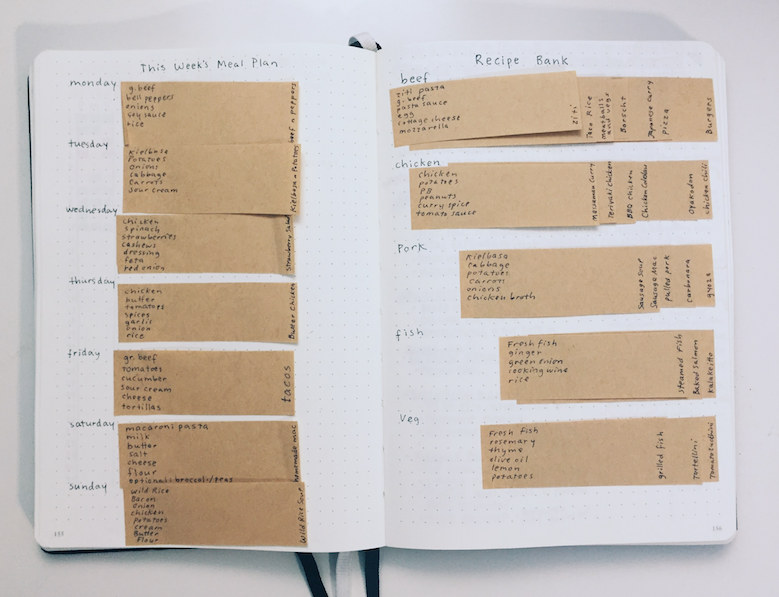
A recipe bank is a really cool collection of all your favorite recipes. You can store all your go-to recipes, all the family classics. You can also put any new foodsyou’d like to try cooking, or want to remember to make again.
This makes it really easy to do your meal planning later! Just look through your recipe bank and pick your meals, then make your shopping list. It’s a great time-saver.
I also love the idea of creating a recipe bank, if you’re a mom or someone else who makes all the food for your family.
If you’re out of town for a while or, god forbid, for good, your family can still enjoy the foods you lovingly create for them.
Notes
Note-taking and the bullet journal go hand-in-hand. Essentially, rapid-logging is just taking quick notes of the important things you want to remember in your life.
You can translate this method into your note-taking and you’ll notice that your notes become clearer and easier to refer to later.
If you’re a student, you can either take your notes in your main bullet journal (remember to add each course’s notes to your index), or use different notebooks for each subject.
As with all things bujo-related, just do whatever is the simplest for you, so that you’ll be more likely to stick with it.
Bullet Journal Collection Pages
Basically, all the things you put in your bullet journal can be classified into different topics, which are called collections. Think of the collections pages as any tasks, notes, or pages that are related to each other.
For example, let’s say you have a few pages that you use to keep track of everything in January. The topic of this collection is January or January logs, and you can list it that way (along with the relevant page numbers) in your bullet journal’s index.
When listing a new collection in the index, just write the collection title (for example, January Logs) followed by the page numbers (24-28). Think of collections like chapters of the bullet journal.
Lumping pages into collections can help you organize and keep track of notes for goals, habits, courses you’re taking, and any ongoing projects you have.
Sometimes your individual collection pages get separated by a few pages in your bullet journal. In order to make it easier to find all the pages of a collection (without having to go back to the index again and again), we use a technique called threading, which is simply noting the other page numbers of a collection.
So, for example, if you have a collection on page 21-22, and it continues on page 30, you can make a note near the bottom of page 22 to indicate that the collection is continued on page 30.
Bullet Journal Migration
Migration is basically a process of reviewing unresolved tasks and deciding whether or not to continue to pursue them.
At the end of each month, look through your past month’s logs. If there are unfinished tasks, you can migrate them to your current log, schedule them for a future date, or, if you feel the task is irrelevant, simply cross it out.
With migration, you can get a better idea of what things are really worth your time and effort.
Bullet Journal Examples
I always find it useful and helpful to look at examples of other peoples’ bullet journals before I start working on my own.
It’s good to see what’s working well for people and how they set things up.
Just keep in mind that everyone’s bullet journal is their own. So don’t try to be like anyone else – make your journal YOUR way!
And now for your guilty pleasure, some great examples of bullet journals for you to enjoy:
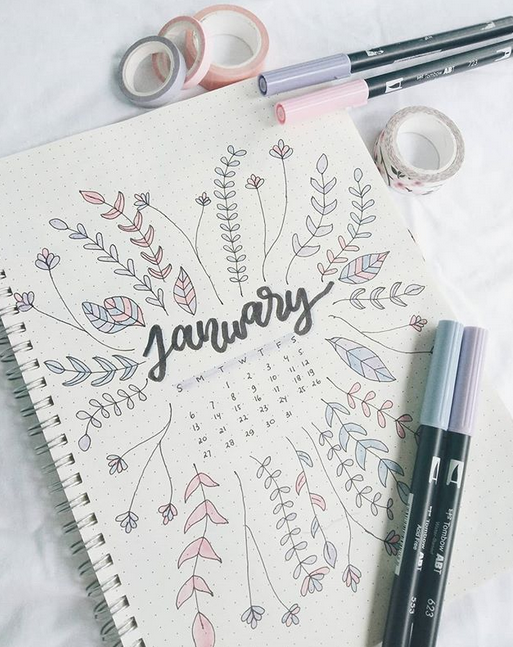
via natyastudies
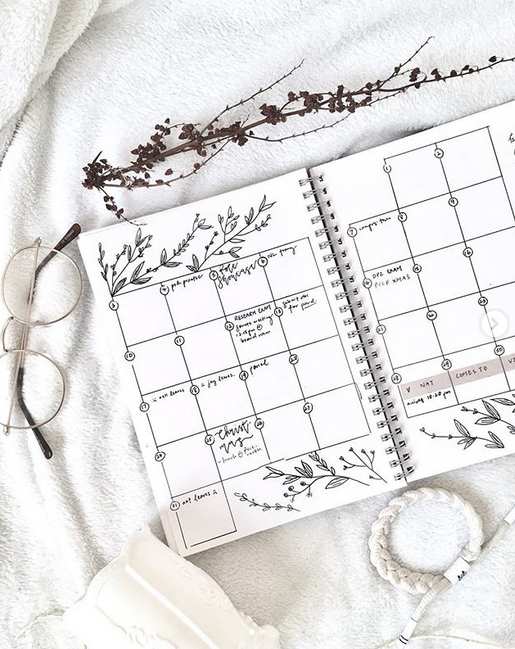
via _liesl.studies_
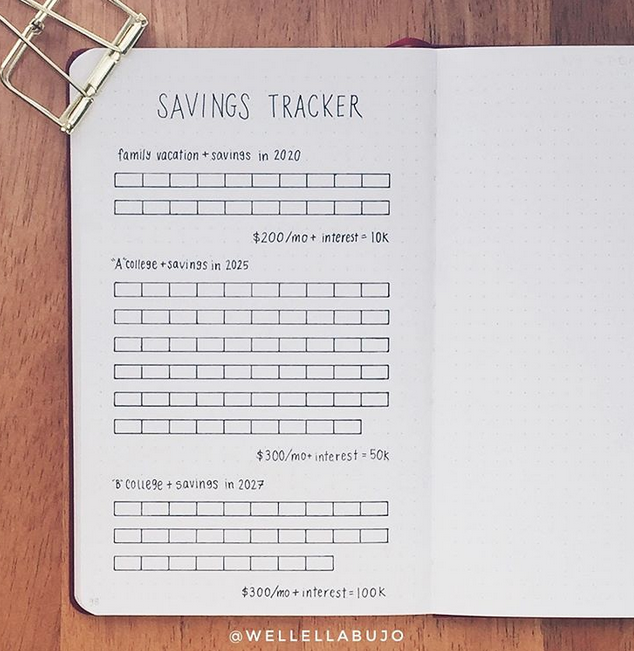
For more bullet journal examples and page ideas, please see my other post { The Big List of Bullet Journal Page Ideas To Try }
I’ve also got a great post for different bullet journal theme ideas if you’re interested!
Bullet Journal Supplies
The supplies you choose to use for your bullet journal will depend on how you want to use it.
Some people use their bullet journal could as an artistic outlet. Others prefer to keep it as simple as possible so it can bring on maximum productivity. In either case you should grab yourself a notebook and pen at the minimum.
Bullet Journal Notebooks
Most people use a dotted grid notebook or a blank journal for bullet journalling. But you can use whatever kind of notebook would be best suited to your needs.
I have a whole guide to picking the best bullet journal notebook here.
Bullet Journal Pens
Many people have asked me which black pen I like the best. The answer to this question is tricky, because it’s often changing!
Here are my favorite bullet journal pens.
Where To Buy Bullet Journal Supplies
In the USA, you can find basic bullet journal supplies, including notebooks and pesn at shops like WalMart and Michael’s.
Amazon also has a great selection of bullet journal supplies.
Click here to see more of my favorite bullet journal supplies!
Conclusion
So, now hopefully you’ve got a pretty good idea of how to set up and use your bullet journal.
There’s just one more thing I’d like to add, and that’s that your bullet journal will only work if you use it! If you do, I have no doubt it’ll help you be more organized and productive.
Don’t worry that your handwriting is chicken scratch or that you don’t have fancy stickers or washi tape – those things don’t matter. Just let your bullet journal be a productivity tool for you, and it’ll be great.
Some people find that they love bullet journalling but feel like they don’t have enough time to work on their bujo. Please read my guide on how to bullet journal if you have no time if that’s you!
If you liked this bullet journal guide and found it useful, please share it on Pinterest or Facebook or leave a comment below.
